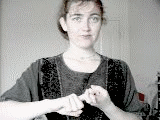Sign English


Interpretation: Welcome Friend
I spent my introduction explaining to you the history of ASL. Sign English has a completely different history.
Sign English was born through the work of deaf educators, primarily from the '70s to this day. Before the '70s, it was illegal to use sign language in residential schools (ex. Western PA School for the Deaf). Anyway, Sign English is divided into multiple different categories, or codes if you will.
Sign English Codes
Rochester Method
Seeing Essential English (SEE1)
Signed Exact English (SEE2)
Conceptually Accurate Signed English (CASE)
Lingistics of Visual English(?) (LOVE)
Rochester Method originated in Rochester, NY. The system requires everything to be fingerspelled (that is, each letter in the alphabet has a handshape that corresponds with it, so a fingerspelled word would be l-i-k-e) except the word "and" and numbers 1-10. This system is naturally quite cumbersome and is rarely used. However, it is the sign code that most closely resembles English.
Seeing Essential English is a code that originated in MN(?) by David Anthony. It follows a 2/3 rule when deciding which sign to use for a specific word. You use the same sign if the word: has the same sound, same spelling, or same meaning. In other words, if a word followed 2/3 of those rules, you use the same sign. It also focuses on the individual sound meanings to formulate signs. For example, the word 'butterfuly' would be signed, but-er-fly instead of using the pretty ASL sign for it. Or the word "campus" would be signed, camp-us, NEITHER sign portrays a college environment anymore than but-er-fly portrays a bug. My biggest criticism goes to the signs for "carpet" portrayed car-pet, gives the portrayal of a car being petted rather than the true meaning. This code is only used among a few small pockets of deaf people and is used in grammar classrooms in the western states (so I hear).
Linguistics of Visual English (LOVE), I hear, is similar to SEE1. However, it is taught in a different manner. But I am not qualified to discuss it in depth.
Signed Exact English (SEE2) came into existance later. This is perhaps my favorite way to teach grammar to Deaf students. It uses ASL signs in an English grammar structure. Educators made up signs representing prefixes, suffixes, some prepositions, conjunctions, etc. For example, the sentence, "I am going to the store.", in SEE2, would be represented as such: I am go-ing to the store . Also, "The butterflies are flying around the yard." would be signed, The butterfly-s are fly-ing around the yard.
The book, Signing Made Natural by Mickey Mantle does a good job of teaching SEE2. I recommend it to anyone wanting to learn Signed English. For conversational purposes, all you need to do is cross off the suffixes, prefixes, and articles (A, an, the). Any Deaf person knowing Signed English will understand that modified SEE2.
Conceptually Accurate Signed English (CASE) is a code that I believe was invented in the early 1990's. This code gives birth to a term called transliteration. Transliterating is using the most conceptually accurate sign possible for a word while maintaining an English grammar structure. For example, instead of saying, "The leaves turned colors.", you'd sign, "Leaves change color". If you want to know more, e-mail me.
Pidgin Signed English is not an official code, nor an actual language pidgin. A language pidgin is a blending of two languages so that both speakers can be understood by eachother. Pidgins, however, do not contain the lingustic complexity of a true language. PSE and CASE are virtually identical. I cannot think of any differences off the top of my head.
I
ASL is the visual/gestural language used by the deaf amongst themselves and with certified interpreters. Deaf people write in English, but sign in ASL. That's why most deaf people are considered bilingual. With the above saying, ASL would say, "Store I go."
When a person is signing,
they need to make sure they are keeping most signs above the waist.
and not above the head(unless they're referring to God). One should speak the words
they sign, since many deaf people can lipread and it assists them to understand
your exact thought. Manual fingerspelling consists of twenty-six different single hand motions, each representing a letter in the alphabet. Manual fingerspelling is also commonly used in EE and PSE, but is sparingly used among native ASL users.
Sign language is also a little weird, some words have more than one sign, such as "Heaven and birthday". Synonyms often share a sign.
For More information on my personal involvement with sign, see My Ministry Page.
Here is some terminology taken from "The Joy of Signing" by Dr.Lottie Riekehof.
Adventitious Deafness-Deafness in persons who are born with normal hearing but in whom the sense of hearing becomes nonfunctional later through illness or accident.
American Sign Language-A visual-gestural langauge used by deaf persons in America.
Audiogram-A graph on which hearing test results are recorded.
Congenital Deafness-Deafness in persons who are born with nonfunctional hearing.
Dactylology-Generally refers to fingerspelling but has been used by some in to include signs as well.
Deaf Persons-Those in whom the sense of hearing is nonfunctional for the ordinary purposes of life.
Expressive Skill-The ability to express oneself in the langauge of signs and fingerspelling.
Fingerspelling-Use of the manual alphabet to form words and sentences.
Hard-of-Hearing Persons-Those in whom the sense of hearing, although defective, is functional with or without a hearing aid.
Interpreting-A signed and fingerspelled presentation of another person's spoken communication.
Lipreading-The ability to understand the oral language or speech of a person through observation of his lip movement and facial expression.
Manual Alphabet-The 26 different single-hand positions representing the 26 letters of the alphabet.
Manual Communication-Communication by use of signs and fingerspelling.
Oralism-A method of training or educating a deaf person through speech and speechreading without employing signs or fingerspelling.
More terms coming later.
Return to my Non-Frames Homepage
Email: mhartman22@hotmail.com

